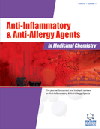-
s The Impact of Inflammatory Profile on Selenium Levels in Hemodialysis Patients
- Source: Anti-Inflammatory & Anti-Allergy Agents in Medicinal Chemistry, Volume 19, Issue 1, Mar 2020, p. 42 - 49
-
- 01 Mar 2020
Abstract
Introduction: Hemodialysis stands out as an eligible treatment for patients with chronic kidney disease. The subsequent inflammatory process resulting from this disease and hemodialysis per se is exacerbated in this therapy. Selenium (Se) is an essential trace element that can participate in the inhibition of pro-oxidant and pro-inflammatory processes and could be considered a measurement that indicates the progression of chronic kidney disease and inflammation. Objectives: The present study investigated selenemia in hemodialysis patients of the ABC region of São Paulo and aimed to establish the correlation between an inflammatory marker and selenemia in this conditions disease. Methods: This is an observational cross-sectional study of the Faculdade de Medicina do ABC in patients submitted to hemodialysis three times a week for at least six months. The eligible group composed of 21 patients, who filled out forms and underwent biochemical tests (colorimetric enzyme methods, flow cytometer, turbidimetric method and mass spectrometry). Results: The study population showed, women (70%), men (30%) with a mean age of 47 ± 17 years, Caucasians (36%) and non-Caucasian (64%), hypertensive (68%), smokers (53%) and non-smokers (64%). There was a hegemonic prevalence of systolic arterial hypertension (SAH) 68.1% in relation to diabetes mellitus (DM) (50%). Pre and post hemodialysis (HD) selenemia showed statistical significance, which did not occur with Creactive protein. There was a predominance of females in our sample; the pre- and post- HD selenemia were within the normal range of the reference values; there was a statistically significant correlation between pre and post-HD selenemia; there was no correlation with statistical significance between values of pre and post-HD C-reactive protein. Conclusion: Our data showed that there was no direct relationship between pre- and post- HD inflammation and pre- and post-HD selenemia.


